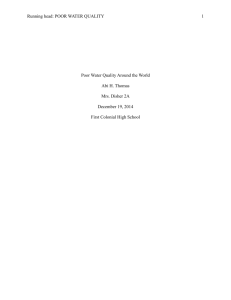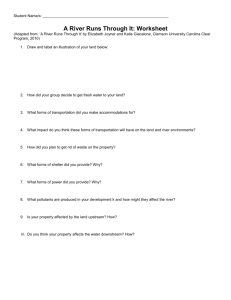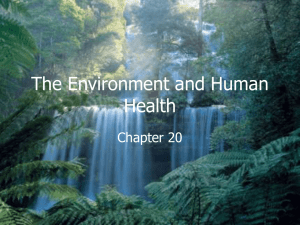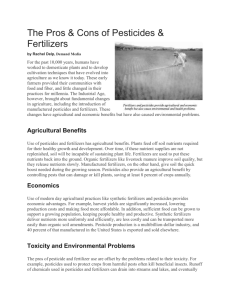Poor Water Quality Around the World
advertisement
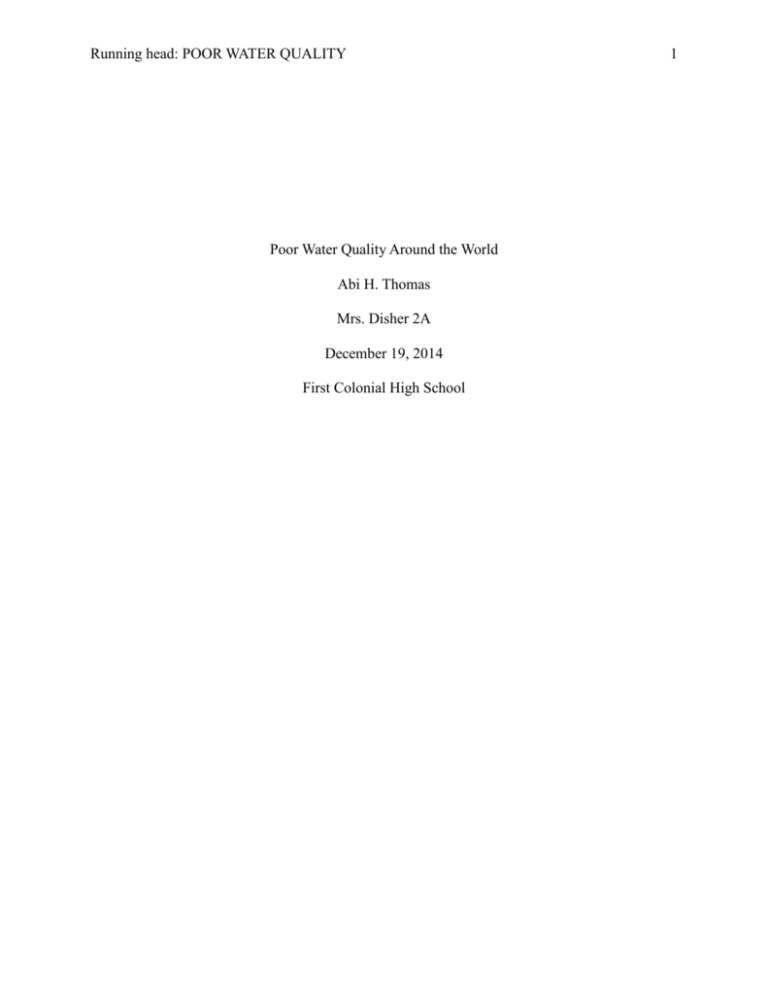
Running head: POOR WATER QUALITY Poor Water Quality Around the World Abi H. Thomas Mrs. Disher 2A December 19, 2014 First Colonial High School 1 POOR WATER QUALITY 2 Abstract Water is vital for life, yet there are more than 1 billion people who lack an adequate source of clean water. Less than one percent of the world’s fresh water supply is available for human use. The water supply is being contaminated by many things. Some of the main sources of pollution are atmospheric deposition, pharmaceutical and personal care product pollution, and the use of fertilizers and pesticides. These chemicals pose a risk to environmental health and the health of animal populations. They can also affect human health both directly through exposure, and indirectly by humans consuming meats and products from the affected animals and fish. Keywords: water, life, pollution, chemicals, health, humans POOR WATER QUALITY 3 Poor Water Quality Around the World The water consumption of the United States is around 150 gallons per person each day, including all the basic needs. According to the United Nations World Health Organization, 5 gallons per person a day is the minimum water requirement. Most people living in undeveloped countries are not able to be provided this minimum fresh water requirement. This leads to about two billion people in the world risking their lives by consuming contaminated water. Water is vital for life, yet there are more than 1 billion people who lack an adequate source of clean water and 2.6 billion without adequate sanitation. There are many contributing factors to poor water quality. They would include atmospheric deposition, pharmaceutical and personal care product pollution, and the use of fertilizers and pesticides. Even though these are a few of the environmental factors of poor water quality, there is hope that they can be controlled through human intervention. These contributing factors were caused by humans and through research and greater knowledge of their effects can be reduced or eliminated. This would improve worldwide water quality. The effects of the contamination of our water system can be seen in our rivers and streams becoming more polluted with chemical by products. This ultimately has an effect on human health because of consuming drinking water, seafood, and meat that have been contaminated with these pollutants. POOR WATER QUALITY 4 Causes There are many causes to water pollution throughout the world. One cause is atmospheric deposition. Atmospheric deposition is defined as pollutants that are released into the air that do not go away. The types of pollutants would include vehicle emissions, agricultural burning, and industrial pollutants from factories. These can be directed deposited into bodies of water, fall with precipitation, or travel by wind. In the United States the Environmental Protection Agency lists personal care products and pharmaceuticals as a growing concern of water quality. These would include prescription drugs, fragrances, cosmetics, sun-screen products, diagnostic agents, and vitamins. Some of these chemicals are able to degrade naturally but others are excreted or washed into the sewer system. Because they dissolve easily and don't evaporate at normal temperatures or pressure, PCPPs make their way into the soil and into aquatic environments via sewage(EPA, 2010). Another cause of poor water quality would be the use of fertilizers with farming and home gardens. The same nutrients in fertilizers that nourish crops, lawns, and golf courses can cause rapid growth of algae, also known as an algal bloom(Moll, 2014). The algal bloom then can cause health problems in humans, because the algae over blooms in the water causing the fish and shellfish to be contaminated. Subsequently causing health issues with people that ingest seafood contaminated with the pathogenic algae. Pesticides are present as another common pollutant to water systems. Many common pesticides such as pyrethroids and organophosphates that are commonly used in agriculture and around homes can potentially pollute ground water and bodies of water through runoff. This is a very similar problem as the pharmaceutical and personal care product pollution in that the POOR WATER QUALITY 5 chemicals runoff into the sewer systems contaminating ground water. In addition, pesticides will naturally runoff into bodies of water during periods of heavy rain (UC-IPM, 2014). Effects Atmospheric deposition has the effect of acidification of waters to a point where the natural buffering capacity of receiving waters is exceeded and aquatic life is threatened. Toxins, such as dioxins, furans, polychlorinated biphenyls, and polycyclic aromatic hydrocarbons, transported by atmospheric processes eventually accumulate in sediments, to the detriment of bottom-dwelling organisms and fish and their consumers (Ministry of Environment, 2015). Thecontaminates of pharmaceuticals and personal care products create a low level exposure to different drugs, soaps, and cosmetics. This happens through drinking contaminated water and having your skin exposed to this water. The low level exposure to the chemicals left in the water can have health consequences many of which are still being researched. Fertilizers create the problem of increased algal blooms in bodies of water. This creates low levels of oxygen along with the increase of some pathogenic algae. The main effects of these algal blooms are on aquatic animals and fish. The animals or fish die or are contaminated. This results in loss of seafood products or contamination of seafood products. By humans consuming the contaminated products it affects their health by exposes them to the pathogenic algae. The use of pesticides has increased over the past century. The leading researchers in ground water contamination by pesticides, the United States Geologic Survey says, “There are many hundreds of these compounds, and extensive tests and studies of their effect on humans have not been completed. That leads us to ask just how concerned we should be about their presence in our drinking water. Certainly it would be wise to treat pesticides as potentially POOR WATER QUALITY dangerous and, thus, to handle them with care. We can say they pose a potential danger if they are consumed in large quantities, but, as any experienced scientist knows, you cannot draw factual conclusions unless scientific tests have been done” (USGS, 2014). They continue research into ground water contamination and its effects on drinking water. They have found several common pesticides including atrazine, diazinon, carbaryl, simazine, and prometon in levels that would be considered as contaminating drinking water in agricultural and urban communities. They are unsure of the potential health effects to people (USGS, 2014). 6 POOR WATER QUALITY 7 This figure shows the many causes of poor water quality. As you can see storm water runoff plays a big role in the causes of poor water quality. It happens when sedimentation and fertilizers run into bodies of water then contaminating them making it unsafe for humans to drink and for animals to drink and live. POOR WATER QUALITY 8 References Atmospheric Deposition. (2015). Retrieved from http://www.env.gov.bc.ca/wat/wq/nps/NPS_Pollution/Atmospheric%20Deposition/air. htm Basic Information. (2010, October 27). Retrieved January 02, 2015, from http://www.epa.gov/ppcp/basic2.html Fertilizers As Pollutants. (2015). Retrieved from http://homeguides.sfgate.com/fertilizerspollutants-78452.html Pesticides and Urban Water Quality—UC IPM. (2014, July 10). Retrieved from http://www.ipm.ucdavis.edu/WATER/U/ Pesticides in the Nation's Streams and Ground Water, 1992–2001—A Summary. (2014, February 18). Retrieved from http://pubs.usgs.gov/fs/2006/3028/
